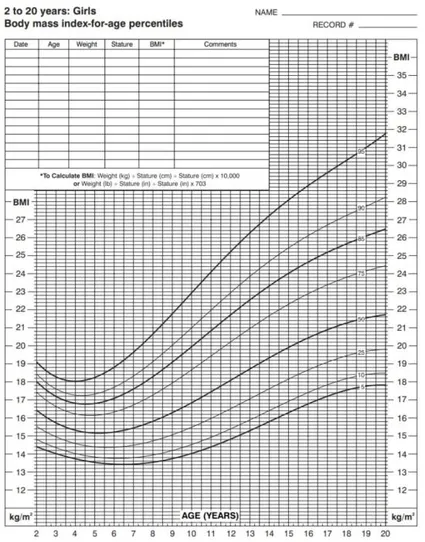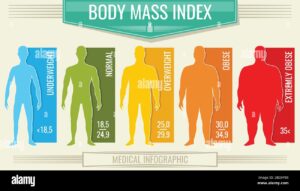Welcome to the BMI calculator for kids, a tool that can be used to calculate BMI for both girls and boys. We also provide BMI charts for youngsters and explain how to read them, as well as why males and girls have different BMIs. Continue reading to discover more about the body and what a healthy BMI for kids is.
What is BMI?
BMI is a method of calculating a person’s mass that considers not only their weight but also their height. The abbreviation BMI stands for Body Mass Index, and calculating it on your own is simple, however, it’s much simpler if you use our BMI calculator for kids. If you insist on doing it yourself, here’s how to calculate your BMI:
BMI = weight / height²
where both weight and height should be in SI units (i.e.: kg and m). This then makes kg/m² the units of BMI. These is not the only units it is possible to use, but are the most widespread, even in the USA. This is due to these units being used by the World Health Organization (WHO) for setting the limits and acceptable ranges of BMI.
Why BMI for kids?
Kids are sometimes described as “little individuals,” and in many respects they are. However, they are still developing physically, which means that many of the regulations and hazards that apply to adults do not apply to children. The BMI for children is the same. When it comes to the BMI for boys or the BMI for girls, there are several elements at play that make it nearly difficult to compare them to an adult in a meaningful way.
Our BMI calculators are divided into five categories. A basic BMI calculator is available, as well as calculators for each of the most readily divided demographic groups: women, men, teenagers, and children.
The gap between the BMI for children and the BMI for teenagers may appear random, but it was created to account for physical changes in individuals. As children approach puberty, their bodies begin to change, and their BMI changes as well. We decided to draw the line at 10 years old since that’s when some girls will begin to experience puberty and their bodies will begin to shift from a child’s body to a woman’s body. On average, boys go through a comparable phase 2-3 years later.
Even if you don’t belong to that category, you could learn something fascinating about BMI and how it relates to health if you navigate to any of the calculators or come back to them later. For the time being, we’ll concentrate on the BMI for children, including how to utilize it as a BMI calculator for boys or a BMI calculator for girls.
BMI chart for kids and the healthy BMI for kids
We discuss the statistical nature of BMI and its inherent difficulty when used as a diagnostic tool in some of our other BMI calculators. This issue, on the other hand, is worsened in children. Doctors always utilize a percentile BMI chart for children when looking at BMI for boys or BMI for girls so they know how healthy the findings are. We’ll go into percentiles in more detail later, but for now, just know that it’s a technique for comparing one person to the rest of the population.
To correctly understand this BMI chart for children, you must first locate the BMI for the girl or boy that we are interested in (instructions on how to do so are provided below).

In most circumstances, a child’s BMI is considered healthy if it falls between 5% and 95% of the population’s BMI. Of fact, this population consists solely of children in their age range.
BMI prime and healthy BMI percentiles for kids
Starting with BMI prime, we should probably clarify a few words that we’ve used in the preceding text and in the BMI calculator for kids itself. This is a BMI-derived quantity that may be calculated using the following equation:
BMI_prime = BMI / 25
The reason for dividing a person’s BMI by 25 is that this is the figure that the World Health Organization considers to be the optimal BMI for adults. Although BMI prime is not a very significant number when discussing BMI for children, we have included it for completeness and so that you may compare not just the values of BMI for children with those of adults, but also the prime version if desired.
We’ll now quickly move on to another result supplied by our BMI calculator for kids: percentiles. Percentiles are statistical categories based on the percentage of the population with a lower BMI than the person in question.
How to use the BMI calculator for kids
It’s not difficult to calculate a child’s BMI by hand, but we’ve made it much easier with our BMI calculator for girls and boys. When comparing the acquired numbers to the BMI charts for children, you will save time and prevent making mistakes if you use our calculator.
The following are the steps to efficiently utilizing the BMI calculator for children:
- Input the kid’s height (the units don’t matter because the calculator will convert them to the right ones for the equation).
- Input the kid’s weight (once again, chose the units you love the most).
- The values for BMI prime and BMI for girls and boys will be computed immediately.
- Input how old the child is in years.
- Input the sex of the child to obtain the right percentiles.
- The percentiles and categorization according to the BMI for kids will be displayed as a text.
Differences between BMI for boys and BMI for girls
By ‘common knowledge,’ you can probably guess that the healthy BMI for girls and boys isn’t going to be the same, but let’s delve at why that is. To begin with, there are differences between boys and girls that are similar to those between men and women, but they are more subtle owing to puberty, which is still occurring for the majority of children at these ages.
Second, there are disparities in physical development between boys and girls, resulting in different BMIs for the two genders. Girls begin developing sooner than males in the final years of childhood and the beginning of the adolescent era, therefore these disparities are more obvious.
Although physical growth has a little influence on the variations in BMI between girls and boys, it becomes more obvious when discussing BMI for teenagers. This impact may be seen in the BMI charts for children, where BMI for boys and girls are practically identical at earlier ages, but they begin to diverge when children reach puberty and the physical characteristics that separate male and female grow to an adult level.


